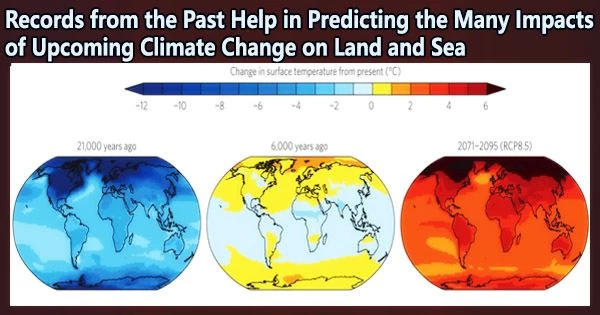Discussions of the ongoing climate change brought on by greenhouse gas emissions frequently refer to global warming. The historic Paris Agreement, for instance, aims to keep global warming to 1.5 degrees Celsius over pre-industrial levels. However, the extent of future warming will not be the same throughout the planet.
The faster warming over land than sea is one of the most obvious geographical variations in climate change. Future warming’s “terrestrial amplification” will have practical effects on how we perceive and respond to climate change.
According to a recent study on terrestrial amplification, scientists can more accurately forecast how much land will warm and become drier than seas as a result of present and future greenhouse gas emissions by using geochemical records of past climate on land and at the sea surface.
“The core idea of our study was to look to the past to better predict how future warming will unfold differently over land and sea,” says Alan Seltzer, an assistant scientist in the Marine Chemistry and Geochemistry Department at the Woods Hole Oceanographic Institution (WHOI) and the lead author of the paper.
“One reason why understanding terrestrial amplification matters is that under future global warming, the magnitude of warming that the planet will experience is not going to be the same everywhere,” says Seltzer. “Adding a firm basis to climate model simulations, that is rooted in observations of past climate and basic physics, can tell us about how the regional differences in ongoing and future warming.”
Seltzer notes that terrestrial amplification (TA) is analogous to “polar amplification,” a prediction of climate models that higher latitudes will experience more warming than low latitudes.
Although large year-to-year changes caused by other components of the climate system make present observational records noisy, the prediction of increased warming over land surfaces is increasingly seen in climate data from the 1980s. Through a theory created by climate scientists over the previous ten years, the drivers of this terrestrial amplification have been connected to variations in moisture over land and sea.
It is remarkable that tropical temperature reconstructions, state-of-the-art climate models, and a simple theory relying on the coupled changes of moisture and heat over continents and oceans all converge to provide a robust estimate of terrestrial amplification. In my view, this strengthens the projections for future climate change, and at the same time brings new understanding of past climate changes.
Masa Kageyama
This new study, published Wednesday in the journal Science Advances, “uses paleoclimate data for the first time to evaluate the theory for how land and sea surfaces will be impacted by future warming,” Seltzer says. “The research gives us more certainty in the way models predict regional changes in future warming.”
The paper investigates terrestrial amplification during the Last Glacial Maximum (LGM) which occurred about 20,000 years ago in the low latitudes, which they define as 30oS-30oN. The authors claim that those latitudes are where the theoretical foundation for TA is most applicable. To calculate the amount of TA in the LGM and compare it to theoretical predictions and simulations from climate models, the authors drew on fresh collections of paleoclimate records from the land and the ocean surface.
The goal of Seltzer’s research at WHOI is to better understand how cold the continents were during the LGM, and this new publication expands on a previous study that used information from dissolved gases trapped in ancient groundwater as a thermometer for the former land surface.
The authors developed a thermodynamic hypothesis for terrestrial amplification based on coupled variations in moist static energy between land and sea, which is the potential energy represented by a parcel of air’s temperature, moisture content, and elevation.
The sea surface was somewhat warmer and more humid during the LGM than it would have been today, when sea level was 120 meters lower than it is now as a result of the expansion of massive ice sheets on land.
The authors were able to compare past terrestrial amplification to forecasts by taking into account this effect and using paleoclimate records. Although the mechanisms underlying TA are well understood to result from fundamental thermodynamic differences between humid air over the ocean and drier air over land, the paper notes that a number of factors, including natural variability, observational constraints, thermal lags, and non-CO2 forcings, have previously prevented a precise estimate of TA from 20th century warming.
“Narrowing the range of terrestrial amplification will aid in future predictions of low latitude climate change, with relevance to both heat stress and water availability,” the paper states.
Co-author Pierre-Henri Blard says the paper is a “step forward for climate science,” and it will be significant for other scientific fields and the general public.
“We show that a simple model, involving humidity and sea level changes, robustly describes the amplification of temperature changes over the continent at low to mid-latitudes at any time scale as being 40% larger than over the ocean. This result is important because, while most paleoclimatic archives are located in the ocean, the present and future of humanity crucially rely on our knowledge of continental climates,” says Blard, a Director of Research at the National Center for Scientific Research (CNRS) at the Center for Petrographic and Geochemical Research (CRPG) in Nancy, France.
The research is important “because it helps us make sense of Earth’s past climate record and how to relate it to our models and expectations for the future,” co-author Steven Sherwood says.
The paper “should clear up any misconceptions that land and ocean warm or cool at the same rate in different climates we know otherwise and should use that knowledge. The implications for the future are that Earth’s continents will continue to warm faster than the oceans as global warming continues, until hopefully we reach net zero and bring this to a stop,” says Sherwood, a professor in the ARC Centre of Excellence for Climate Extremes in the University of New South Wales’s Climate Change Research Center, Sydney, Australia.
Co-author Masa Kageyama says she considers the paper important “because it touches on a feature which is ubiquitous in climate change projections, produced by complex climate models: continents warm more than oceans.”
“In this paper, we analyze this feature for a climate change, from the last glacial maximum to present, the amplitude of which is of the same order of magnitude as the expected warming in the next centuries,” says Kageyama, director of research at CNRS’ Climate and Environment Sciences Laboratory (LSCE) at the Pierre Simon Laplace Institute at the University of Paris-Saclay, France.
“It is remarkable that tropical temperature reconstructions, state-of-the-art climate models, and a simple theory relying on the coupled changes of moisture and heat over continents and oceans all converge to provide a robust estimate of terrestrial amplification,” says Kageyama. “In my view, this strengthens the projections for future climate change, and at the same time brings new understanding of past climate changes.”
Funding for this research was provided by a National Science Foundation Division of Earth Sciences award and by the French National Centre for Scientific Research.
















